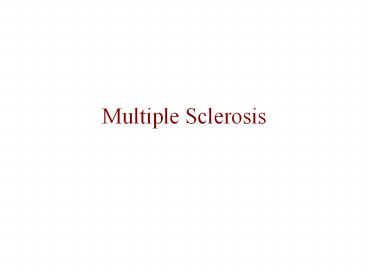Multiple Sclerosis - PowerPoint PPT Presentation
Title:
Multiple Sclerosis
Description:
Multiple Sclerosis Diagnostic Criteria: MRI EVIDENCE OF DISSEMINATION IN TIME : A gadolinium-enhancing lesion detected in scan at least 3 months after onset of ... – PowerPoint PPT presentation
Number of Views:231
Avg rating:3.0/5.0
Title: Multiple Sclerosis
1
Multiple Sclerosis
2
Multiple Sclerosis
- Inflammatory demyelinating disease of the central
nervous system. - Most common cause of neurological disability in
young adults.
3
Multiple Sclerosis
- Epidemiology
- 940 patients followed at the multiple sclerosis
clinic of the Montreal Neurological Institute
4
Multiple Sclerosis
- Epidemiology
- Sex ratio FM 1.771.00
- Prevalence ranges from lt5 to 60 per 100 000.
Higher in Europe and North America. - South Africa White population 5-25/100 000.
- Genetics Sibs 3-5 risk. Monozygotic twins
20-38 risk
5
Multiple Sclerosis
- Temporal patterns
- Relapsing-remitting (RR) MS 55
- Secondary progressive (SP) MS 31
- Primary progressive (PP) MS 9
- Progressive relapsing (PR) MS 5
6
Multiple Sclerosis
- Pathophysiology Demyelination
7
Multiple Sclerosis
- Pathophysiology
- Consequences of demyelination
- Slowing of conduction
- Conduction block
- Uhthoffs phenomenon Temperature
- Mechanical stimulation
8
Multiple Sclerosis
- Pathophysiology
- Axonal injury
- Usually occurs later, but also evidence of early
loss.
9
Multiple Sclerosis
- Pathophysiology
- Recovery
- Early Resolution of oedema, cytokines, pH
- Intermediate Increase in internodal Na channels
- Later Remyelination
10
Multiple Sclerosis
- Pathophysiology
- Immunological disease
- Complex, not fully elucidated, various patterns.
- Disruption of perivenular BBB.
- Migration of T cells (CD8CD4) and macrophages.
- Macrophages occur in centre of lesion, associated
with oligodentrocyte destruction and
demyelination. - In periphery of lesion Remyelination by
surviving oligodendrocytes and even
oligodendrocyte proliferation. - Plaques Discreet areas of demyelination,
macrophage, and T-cell infiltration,
astrocytosis.
11
Multiple Sclerosis
- Radiological features
12
Multiple Sclerosis
- Clinical features
- Cranial nerve deficits
- Optic neuritis common
- Oculomotor involvement
- Isolated nerves VIgtIIIgtIV
- Internuclear ophthalmoplegia
- Nystagmus
- Trigeminal neuralgia
- Facial palsy, but Taste not affected.
- Hemifacial spasma and myokemia
- Pseudobulbar palsy common in later stages
13
Multiple Sclerosis
- Clinical features
- Sensory symptoms
- Common
- Various patterns
- Often paresthesias, dysesthesias and other
positive symptoms. - Plaques involving dorsal root entry zones are
common radicular pain or severe loss of
proprioception useless hand with normal power.
14
Multiple Sclerosis
- Clinical features
- Motor features
- Usually later than sensory
- Hemiparesis with cerebral or brainstem lesions
- Acute partial myelitis.
- Gradually progressive paraparesis characteristic
of progressive forms of MS. - Cerebellar features - common
15
Multiple Sclerosis
- Clinical features
- Impairment of Bladder, Bowel, and Sexual
Functions - Urgency and urgency incontinence
- Dyssynergic voluntary sphincter activity
- With involvement of sacral spinal segments
Hypotonic bladder with overflow incontinence. - Constipation gt fecal incontinence
- Sexual dysfunction
16
Multiple Sclerosis
- Clinical features
- Cognitive Impairment
- Subtle and underreported.
- Subcortical Abstract conceptualization, recent
memory, attention, and speed of information
processing - Affective Disorders
- Depression 50 risk. Higher than with other
chronic neurological diseases. - Fatigue
17
Multiple Sclerosis
- Clinical features
- Characteristic positive features
- Lhermittes phenomenon - Electric shock radiating
down the spine or into the limbs on flexion of
the neck. - Uhthoffs phenomenon Worsening of existing
symptoms - Trigeminal neuralgia, central pain, paraspinal
spasms, myokemia, phosphenes and a variety of
other paroxysmal neurological symptoms.
18
Multiple Sclerosis
- Diagnostic Criteria
- Revised McDonald et al. (2005) Diagnostic
Criteria for Multiple Sclerosis
19
Multiple Sclerosis
- Diagnostic Criteria
- Positive MRI 3 or more
20
Multiple Sclerosis
- Diagnostic Criteria
- MRI EVIDENCE OF DISSEMINATION IN TIME
21
Multiple Sclerosis
- Prognosis
- Poor prognostic indicators
- Male
- Older onset
- Progressive from start
- Frequent initial relapses
- Pyramidal or brainstem rather that optic neuritis
or sensory symptoms. - Pure optic neuritis, without brain lesions has
good prognosis, only 16 progress to MS in 5
years. Compared to 51 with 3 lesions.
22
Multiple Sclerosis
- Treatment
- Acute attacks Methyl-Prednisolone 500mg to
1000mg daily x3-5/7.
23
Multiple Sclerosis
- Treatment
- Disease modifying treatment in RRMS
- Interferon beta-1a (Avonex) 30ug IMI/w
- Interferon beta 1a (Rebif) 22-44ug SC 3x/w
- Interferon beta-1b (Betaferon) 8MIU alt days
- Glatirimer acetate (Copaxone) 20mg daily
- Mitoxanthrone
- Natalizumab (Tysarbi)
24
Multiple Sclerosis
- Treatment
- Disease modifying treatment in SP and PRMS
- Mitoxanthrone
- Interferon beta-1b (Betaferon)
- Cyclophosphamide ??
- Azathioprine ??
- Methotrexate ??
- Monthly 3 monthly pulses of Solumedrol ??
25
Multiple Sclerosis
- Treatment
- Disease modifying treatment in PPMS
- ???































